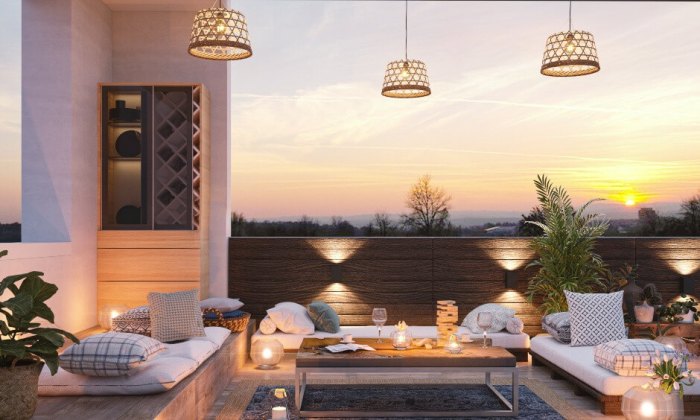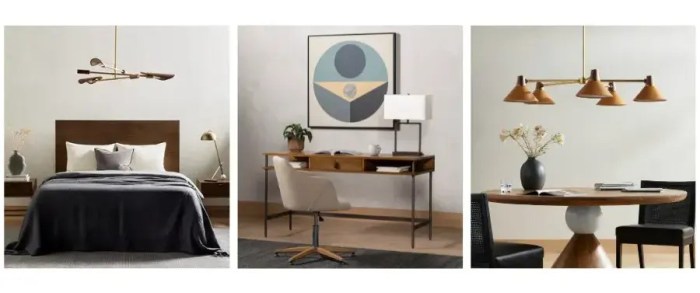Choosing the right lighting for rooftop spaces sets the stage for unforgettable evenings under the stars. Rooftop areas offer a unique opportunity to blend indoor comfort with outdoor charm, and the right lighting can transform these spaces into inviting retreats. From ambient to task lighting, exploring the ideal choices can enhance your experience, whether you’re hosting a lively gathering or enjoying a quiet night alone.
This guide dives into various types of lighting suitable for rooftops, comparing options like LED, solar, and traditional fixtures while highlighting how to design an effective lighting layout. Moreover, it emphasizes the importance of selecting decorative fixtures that enhance ambiance while ensuring safety and weather resistance. Understanding these elements is crucial for creating a rooftop oasis.
Selecting the Right Type of Lighting
Selecting the right lighting for rooftop spaces is crucial for creating an inviting atmosphere, ensuring safety, and enhancing the aesthetic appeal of the area. A well-lit rooftop can transform a simple open space into a vibrant outdoor retreat. Understanding the various types of lighting available will help in making informed decisions that cater to both functional and decorative needs.When choosing lighting for rooftop spaces, it is essential to consider the three main types: ambient, task, and accent lighting.
Each type serves a unique purpose and can be utilized to achieve different effects. Ambient lighting provides general illumination, task lighting highlights specific areas for activities such as dining or reading, and accent lighting adds visual interest by highlighting architectural features or plant life.
Types of Lighting Options
When evaluating different lighting options, one must consider various factors like energy efficiency, cost, and lifespan. Below are some common lighting technologies suitable for rooftop spaces, along with their advantages and disadvantages:
- LED Lighting:
LEDs are highly energy-efficient, with a lifespan of up to 50,000 hours.
Advantages include low energy consumption and minimal heat emission. However, initial costs can be higher compared to traditional bulbs.
- Solar Lighting:
Solar lights harness energy from the sun, making them eco-friendly.
They are cost-effective in the long run and require no wiring. On the downside, they may not perform well in cloudy conditions and can have limited brightness.
- Traditional Lighting (Incandescent/Fluorescent):
Traditional lights are widely available and inexpensive.
While they offer warm light, they are less energy-efficient and have shorter lifespans compared to LEDs.
Comparison of Lighting Types
To facilitate a clearer understanding of different lighting options, the following table compares LED, solar, and traditional lighting based on critical factors:
| Lighting Type | Energy Efficiency | Initial Cost | Lifespan |
|---|---|---|---|
| LED | High | Moderate | 50,000 hours |
| Solar | Moderate (Depends on sunlight) | Moderate to High | 30,000 hours |
| Traditional | Low | Low | 1,000 hours (Incandescent), 10,000 hours (Fluorescent) |
Making the right choice in lighting will not only enhance the usability of rooftop spaces but also contribute to energy savings and the overall aesthetic appeal of the area. Each lighting type has its strengths and weaknesses, and understanding these can lead to a well-lit, harmonious rooftop experience.
Designing a Lighting Layout

Creating an effective lighting layout for rooftop spaces is essential for maximizing the utility and enjoyment of these areas. Properly planned lighting not only enhances the aesthetic appeal but also ensures safety and functionality for various activities. This guide Artikels a step-by-step approach to designing a lighting layout that accommodates different purposes, from dining to relaxation.To create a successful lighting layout, it is important to consider the specific zones for your rooftop space.
Each zone should be tailored to the activities expected to take place there, with appropriate lighting that enhances the experience while providing safety and comfort. Below is a structured guide for designing your rooftop lighting layout.
Step-by-Step Guide to Lighting Layout Design, Choosing the right lighting for rooftop spaces
When designing the lighting layout, follow these key steps to ensure that each area of your rooftop serves its intended purpose effectively.
- Evaluate the Space: Begin by assessing the dimensions and layout of your rooftop. Identify areas for specific activities like dining, lounging, or gardening.
- Determine Lighting Needs: Consider the type of activities that will take place in each zone and the amount of light required. For instance, dining areas may need brighter lighting compared to relaxing spaces.
- Choose Lighting Fixtures: Select appropriate fixtures based on style, functionality, and energy efficiency. Options may include LED string lights, wall sconces, or floor lamps.
- Design Layout Zones: Divide the rooftop into distinct zones, each with its specific lighting requirements.
- Plan Electrical Sources: Ensure that power outlets are conveniently located for your lighting fixtures and that the wiring is safely installed.
- Test & Adjust: Before finalizing your layout, test the lights in different settings to see how they illuminate the space. Adjust fixture placement as needed for optimal light distribution.
Incorporating Lighting Zones for Different Activities
Creating lighting zones allows for a tailored atmosphere suited to various activities on the rooftop. Each zone should be distinct, ensuring that the lighting serves its intended purpose effectively. Below is a table detailing suggested lighting placements and their corresponding purposes.
Further details about Ideas for rooftop party decorations and themes is accessible to provide you additional insights.
| Zone | Lighting Type | Purpose |
|---|---|---|
| Dining Area | Suspended pendant lights or string lights | Provide bright, focused light for dining; create an inviting atmosphere. |
| Lounging Area | Soft, ambient floor lamps or wall sconces | Enhance relaxation with warm light; encourage social interaction. |
| Gardening Space | Spotlights or task lighting | Illuminate specific plants and working areas; facilitate gardening during evening hours. |
| Entertainment Zone | Color-changing LED lights or fairy lights | Create a vibrant atmosphere; set mood for movie nights or gatherings. |
| Walkways | Recessed lights or solar path lights | Ensure safety and visibility; guide guests through the space comfortably. |
“A well-designed lighting layout not only enhances the beauty of rooftop spaces but also elevates the overall experience, making it feel like an extension of your home.”
Enhancing Ambiance with Lighting Fixtures: Choosing The Right Lighting For Rooftop Spaces

Creating a captivating ambiance in rooftop spaces involves careful selection and placement of lighting fixtures that not only illuminate but also enhance the overall aesthetic. The right fixtures can transform an ordinary rooftop into a tranquil escape or a vibrant entertaining space. Understanding the interplay between design and function is key to achieving the desired atmosphere.Lighting fixtures serve as both practical tools and decorative elements.
Selecting decorative lighting that aligns with the rooftop’s theme can elevate the entire space. Consider how various styles of fixtures can complement the architecture and furnishings of your rooftop. Using dimmable lights is another effective method for adjusting the ambiance according to different occasions, allowing you to create a cozy atmosphere for intimate gatherings or bright lighting for lively parties.
Selection of Decorative Lighting Fixtures
Choosing decorative lighting fixtures is essential for creating an ambiance that reflects your personal style and complements the rooftop’s design. Here are some tips to guide your selection:
Assess the overall theme
Ensure that the lighting fixtures align with the existing design elements of the rooftop.
Scale and proportion
Choose fixtures that are appropriately sized for the space. Oversized fixtures can dominate a smaller area, while tiny lights may get lost in a vast space.
Material and finish
Opt for materials that withstand outdoor conditions while matching the aesthetic, such as weather-resistant metals or glass.
Layered lighting
Combine different types of fixtures, such as wall sconces, pendant lights, and string lights, to create depth and warmth.Furthermore, the use of dimmable lights allows for maximum versatility in how the space is used throughout the day and night.
Popular Lighting Styles
When considering the aesthetic of your rooftop, selecting the right lighting style can have a profound impact. Below are several popular lighting styles that can enhance the ambiance of your rooftop space:
Modern
Clean lines, minimalistic designs, and often featuring materials like metal and glass. Perfect for contemporary rooftops.
Rustic
Incorporates natural elements such as wood, wrought iron, and vintage finishes. Ideal for a cozy, farmhouse-style setting.
Industrial
Characterized by raw, unfinished materials, exposed bulbs, and utilitarian designs. Works well in urban environments or loft-style rooftops.
Bohemian
Features eclectic and colorful designs, such as pendant lights with intricate patterns. Adds a relaxed, artistic vibe.
Mediterranean
Often includes lantern-style fixtures and warm finishes, reminiscent of coastal getaways. Great for creating a vacation-like atmosphere.Implementing these styles thoughtfully will ensure your rooftop space not only shines but also resonates with your intended ambiance.
Safety Considerations for Rooftop Lighting
Rooftop lighting plays a crucial role in enhancing both the aesthetic and functional aspects of outdoor spaces. However, safety should always be a top priority during installation and maintenance. Understanding the essential safety standards and regulations, as well as implementing secure and weather-resistant designs, can prevent accidents and ensure longevity of the lighting systems.Adhering to safety standards and regulations is fundamental in rooftop lighting installations.
These standards vary by location, but generally, they encompass electrical safety codes, structural integrity requirements, and specific guidelines for outdoor installations. Compliance with local building codes, such as the National Electrical Code (NEC) in the United States, ensures that lighting systems are safely integrated into the rooftop environment. This not only protects the users but also minimizes liability risks for property owners.
Essential Safety Standards and Regulations
Several key regulations guide the safe installation of rooftop lighting systems. Familiarizing yourself with these can significantly enhance safety:
- Local Building Codes: Ensure compliance with municipal regulations that dictate structural and electrical standards for rooftop installations.
- National Electrical Code (NEC): Familiarize yourself with NEC guidelines to prevent electrical hazards, including proper grounding and circuit protections.
- OSHA Regulations: Adhere to Occupational Safety and Health Administration (OSHA) guidelines to ensure worker safety during installation and maintenance processes.
Secure and Weather-Resistant Lighting Fixtures
Selecting the right lighting fixtures is vital for the safety and durability of rooftop lighting systems. Fixtures must be designed to withstand various weather conditions, such as rain, snow, and extreme temperatures. Utilizing fixtures that have a suitable IP rating (Ingress Protection) helps in determining their resistance to dust and water.Also, consider materials that are rust-resistant, such as aluminum or stainless steel, which can prolong the life of your lighting fixtures and prevent accidents caused by corrosion.
Checklist of Safety Features
When choosing and installing rooftop lighting, the following checklist of safety features will help ensure a secure and efficient setup. This will serve as a reliable guide during the selection and installation process:
- ✔ Waterproof ratings: Look for fixtures with a minimum IP65 rating to ensure they can resist water intrusion.
- ✔ Secure mounting: Use robust mounting hardware and brackets designed for rooftop applications to prevent fixtures from becoming dislodged.
- ✔ UV protection: Opt for fixtures with UV-resistant materials to prevent degradation from sun exposure.
- ✔ Anti-glare features: Choose fixtures designed to minimize glare, improving visibility and safety for users.
- ✔ Circuit protection: Implement surge protectors and circuit breakers to guard against electrical surges.